Manchester Square is the subject of this week’s post. Georgian architecture, a Marchioness who had intimate meetings with the Prince Regent and an original lane that once ran through fields and now runs through the streets of Georgian London.
Manchester Square is a short distance north of Oxford Street and a perfect example of how in London you can walk in a matter of minutes from streets crowded with people and traffic to a peaceful place that is full of history and wonderful architecture.
Manchester Square still has the much of the original Georgian and Regency period houses from when the square was built, along with an original London town house that occupies one full side of the square. In the centre of the square is a garden which looked fantastic when I visited on a sunny spring day.
Construction of Manchester Square was part of the Georgian expansion of London. The land formed part of the Portman Estate (as it still does) and a lease on a plot of land was granted to George Montagu, fourth Duke of Manchester who commenced construction in 1776 of a house on the north side of the square.
Other builders purchased leases on the other three sides of the square, the central gardens were laid out, and Manchester Square came into existence, named after the Duke, as was his house, which on completion in 1788 became Manchester House.
Soon after the completion of his house, the Duke died. The house was then purchased by the Spanish Government as their London embassy, a role it occupied until 1797 when the second Marquis of Hertford purchased the lease and renamed the house as Hertford House (and this is where the Marchioness of Hertford became a rather scandalous London figure – more later in this post).
The second Marquis died on 1822 and the house passed to the third Marquis, then in 1842 to the fourth Marquis of Hertford who was a collector of art, furniture, china etc. scouring the auction rooms of Europe to put together a very large collection that was stored in his houses in London and Paris. The fourth Marquis of Hertford died in 1870. He was unmarried and with no children, left his entire collection to his friend Sir Richard Wallace (who was also a collector). Wallace made a number of changes and extensions to the house to form the building that we see today.
The combined collection became known as the Wallace Collection, and on the death of Sir Richard Wallace, the collection was bequeathed to the nation, and it is this collection which is now housed in Hertford House
Hertford House, home of the Wallace Collection in Manchester Square:
Manchester House soon after completion and before it became Hertford House:
Standing in Manchester Square it is hard to believe that you are only a couple of minutes from Oxford Street. The central gardens are an oasis of green, spring blossom is blowing across the street and the few people around are either heading to the Wallace Collection, or using the street as a local parking place for Oxford Street.
The original plan for Manchester Square was for a church to be built in the central square, however this did not get built and the gardens were laid out between 1776 and 1788.
The second Marquis of Hertford who purchased Manchester House and renamed it Hertford House was a good friend of the Prince of Wales (who would later become George IV) and the Prince of Wales was a regular visitor to Hertford House, however it was his interest in the Marchioness, Lady Hertford that appears to have been his main reason for making the journey to Manchester Sqaure. It was written at the time that “The Prince does not pass a day without visiting Lady Hertford, indeed so notorious did these calls on ‘the lovely Marchesa’ become that a scurrilous print inserted in its columns the following advertisement: Lost, between Pall Mall and Manchester Square, his Royal Highness the Prince Regent”.
The relationship between the Prince of Wales and Lady Hertford was also the subject of a number of satirical cartoons. The following cartoon from 1819 shows Lady Hertford and the Prince Regent, the Prince of Wales on one of the new velocipedes. The signpost on the left is pointing to Wales and Hertford.
©Trustees of the British Museum
The following carton shows a room in Hertford House with Manchester Square seen through the windows. The Prince Regent on the right is walking towards Lady Hertford. The Prince is holding the Privy Purse and the small character inside the purse is John McMahon who at the time was the keeper of the Privy Purse and the official private secretary to the Prince.
The Prince is saying to Lady Hertford: “I am so partial to the Privy Purse my Lady; that I have turn’d it into a Ridicule that I may have it always about me.” and she replies: “Well! upon my Honor, our Friend has got a snug birth there indeed.”
The two men talking in the square seen through the window are talking about the bad news of the day being that McMahon is now the keeper of the Privy Purse (and will do exactly what the Prince requires) and the Prince is therefore holding the Privy Purse up to ridicule.
©Trustees of the British Museum
The Marchioness, Lady Hertford was considered one of the reigning beauties of the day. The Irish poet, Thomas Moore, initially a good friend of the Prince wrote of Lady Hertford:
“Or who will repair unto Manchester Square,
And see if the lovely Marchesa be there?
And bid her to come, with her hair darkly flowing,
All gentle and juvenile, crispy and gay,
In the manner of Ackerman’s dresses for May.”
Portrait of Isabella Anne Ingram Shepherd, 2nd Marchioness of Hertford by Sir Joshua Reynolds:
©Trustees of the British Museum
When Manchester Square was built, London was expanding rapidly to the west and north. The area to the north of Oxford Street was being turned from fields to wide, formal streets and squares. To see what the area was like immediately before Manchester Square was built, I turned to John Rocque’s map of 1746, just 30 years before construction started on Manchester Square.
The following map shows the area on which Manchester Square would be built.
I wanted to see if I could place Manchester Square in Rocque’s map and whilst doing so, found what I believe to be an original street remaining from when the area was all fields.
See the two maps below. On the left is Roqcue’s map of the area and on the right a Google map of the same area. If you look to the lower right of both maps, the 1746 extent of building can be seen.
I have shown the modern street names in red on the Google map. In the 270 years since Roqcue’s map there have been some subtle changes in street names:
Wigmore Row in 1746 is now Wigmore Street
Wellbeck Street is now Welbeck Street (it has lost an ‘l’)
Wimple Street is now Wimpole Street
Henrietta Street is now Henrietta Place
The dotted line in the Google map is the location of Wimple Mewse which has disappeared since the Rocque map.
The extent of the building in 1746 is along Marybone Lane, this is now Marylebone Lane. I have marked the name in red in the Google map, however where it gets really interesting is if you follow Marylebone Lane north across Wigmore Street you will see that it curves to the left, following roughly the same curved path as Marybone Lane in 1746.
Marylebone Lane today is different to the majority of other streets in the area. It is a much narrower street and is not a formal straight street as are nearly all the others in the area. Also, look just above Wigmore Row in the 1746 map and Marybone Lane curves to the left to avoid a pond in the field, I have marked the rough position of this pond on the Google map by the blue oval.
I suspect that Marylebone Lane today follows the same alignment as Marybone Lane when it originally ran through open fields and the curved route of today avoids a long lost pond that is now under the Holiday Inn Hotel between Welbeck Street and Marylebone Lane.
I have marked my estimate of where Manchester Square would later be built on the 1746 Roque map, in the middle of a rather large field.
If I am right, it is remarkable that with the considerable 18th and 19th century development of this area, and the laying out of wide streets in straight lines, it is still possible to walk down a street that once ran through open fields and is probably many hundreds of years old.
After that diversion, let’s return to Manchester Square to admire the architecture.
Many of the buildings surrounding the square have the wrought iron balconies of the late Georgian / Regency period.
And as you might expect, there are plenty of Blue Plaques to be found. This one for Alfred Lord Milner, who started as a journalist, then was a civil servant before becoming High Commissioner for South Africa and Governor of the Cape Colony during times of considerable tension which led to the 2nd Boer War. On return to London he was chairman of the Rio Tinto mining company, a Director of the Joint Stock Bank and continued to have a number of roles in the Government, continuing to travel widely.
The south west corner of Manchester Square.
Below is the south east corner of Manchester Square. The windows in these buildings clearly show the impact of the 1774 Buildings Act which took the 1709 requirement for the windows to be recessed by 4 inches and added the requirement for the sash box to be hidden behind the brickwork. The main reasons for these changes were to prevent the spread of fires and the risk of the sash window falling out, but was also driven by the fashion of an austere and simple window design.
Blue plaque to Sir Julius Benedict, a German composer and conductor who spent the majority of his life in London.
And in the same corner of the square a blue plaque to John Hughlings Jackson, a prominent neurologist, whose work on epilepsy resulted in an improved ability to diagnose and understand the condition.
Blocked up windows on the side of one of the buildings in Manchester Square, possibly to reduce the amount of Window Tax paid by the occupiers. The windows are blocked on the side street from the square so the main frontage of the building onto Manchester Square has the full complement of windows. The owner would not want the view of his house facing to the square to be any different from his neighbours and savings would be made where parts of the house were less visible.
A different architectural style on the north east corner of Manchester Square:
One of the streets leading off Manchester Square (to the right of Hertford House) is Spanish Place – the name recalling the Spanish connection of Hertford House when it was home to the Spanish Embassy.
Some of the original houses in Spanish Place. As with many of the houses in the main square, they have the Georgian form of windows as well as the fanlight, arched window above the door:
With yet more blue plaques. This time to Captain Frederick Marryat, a Royal Naval officer and author and also to George Grossmith, who was a theatre director, actor and playwright.
Manchester Square and the surrounding area is fascinating. This area grew considerably during the Georgian period as London expanded rapidly to the west and north of Oxford Street and there are many fine streets and squares to be found, and Marylebone Lane looks to be a survivor from the time when this area was all fields.
The legacy of the 4th Marquis of Hertford and Sir Richard Wallace with the Wallace Collection housed in Hertford House is well worth a visit and whilst walking the rooms of Hertford House you are also walking the site of the Prince Regent, the Prince of Wales many visits to meet with the Marchioness, Lady Hertford.

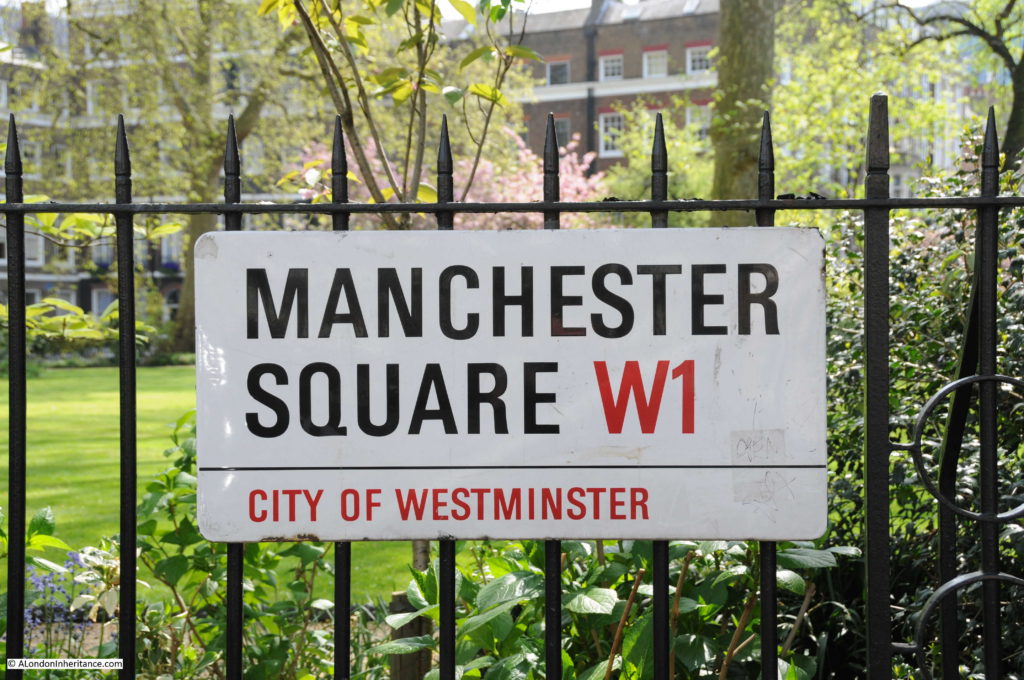

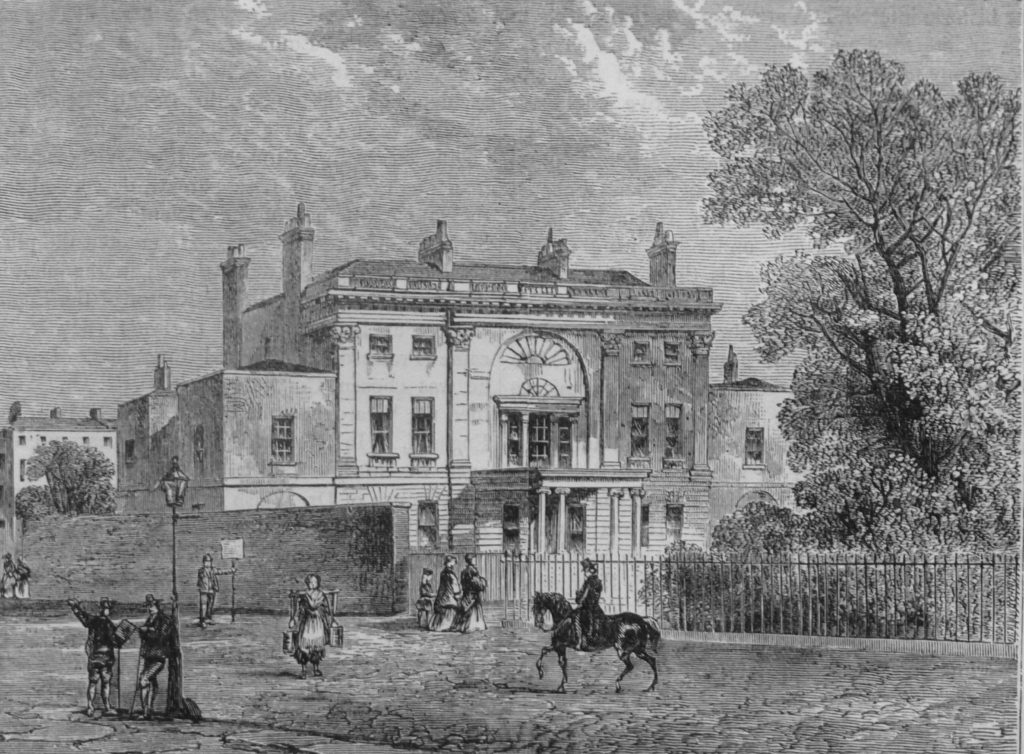

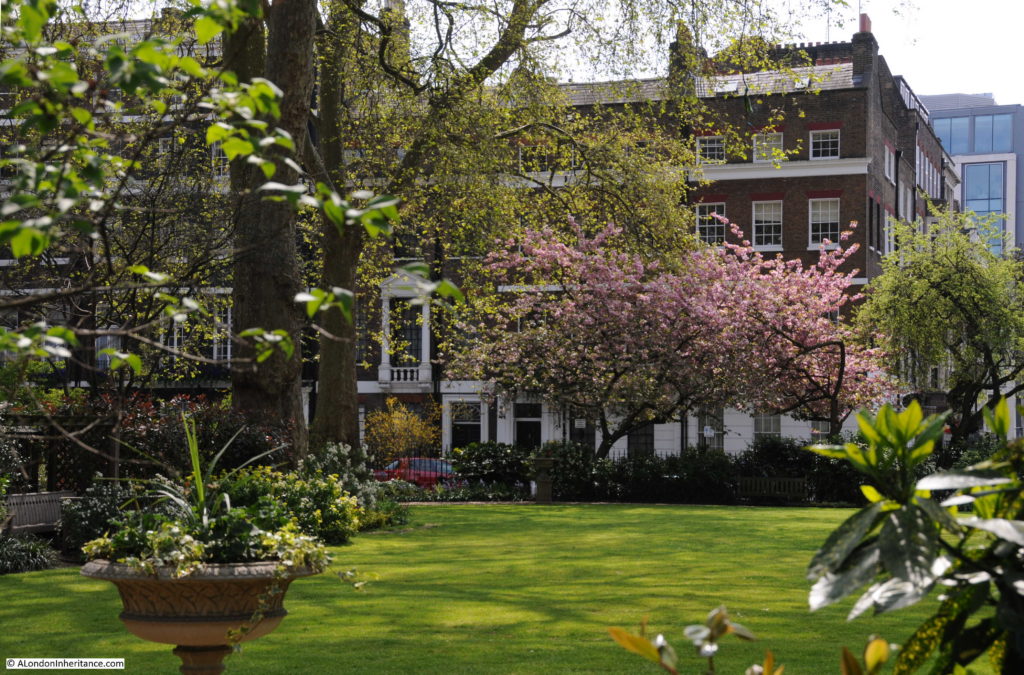
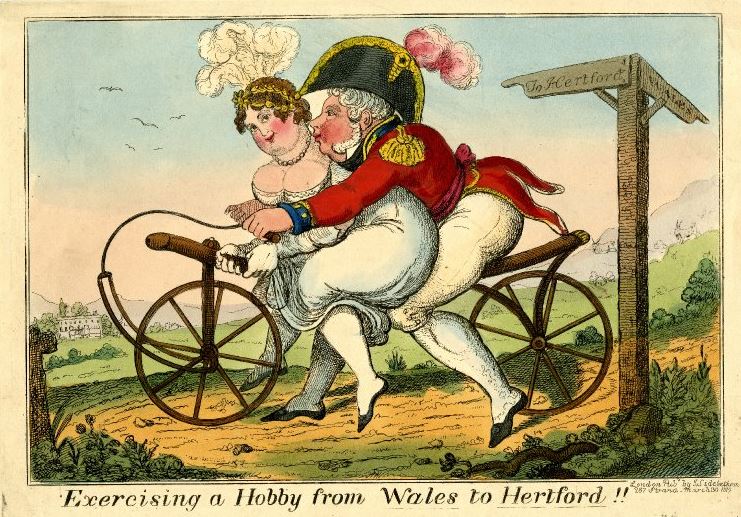
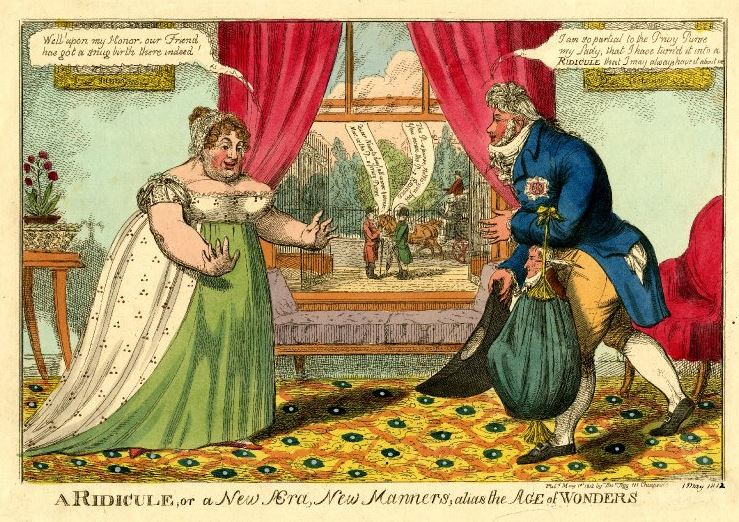
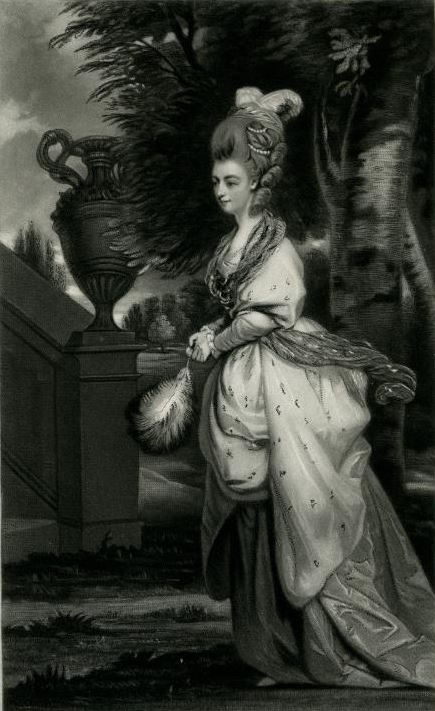
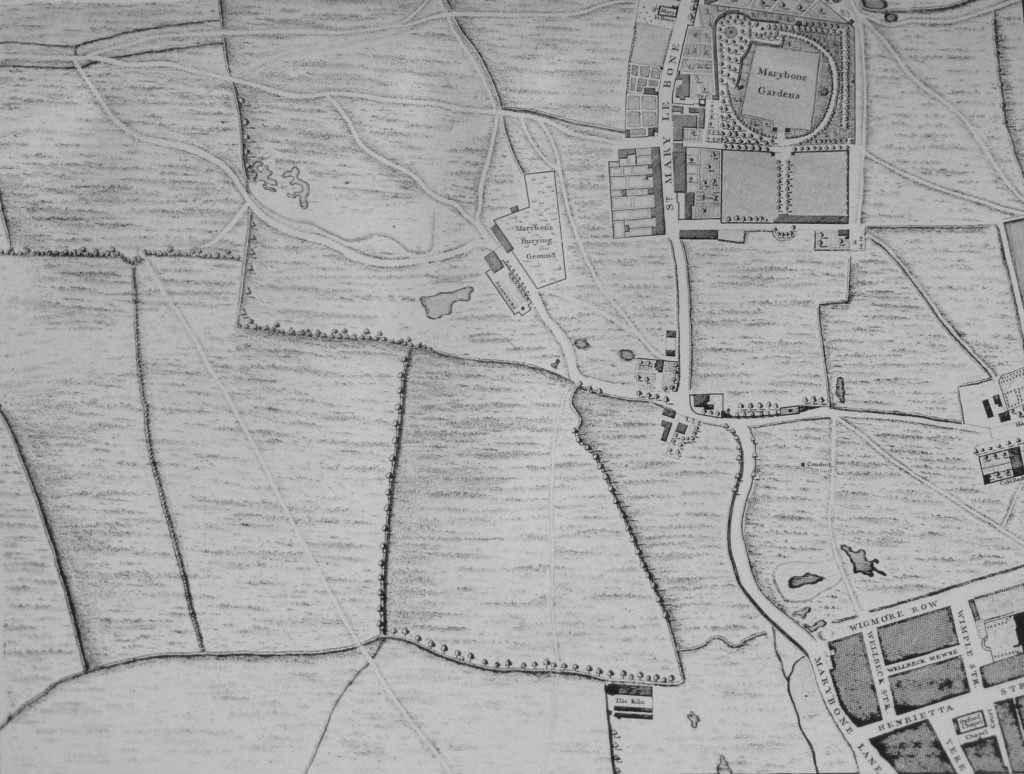
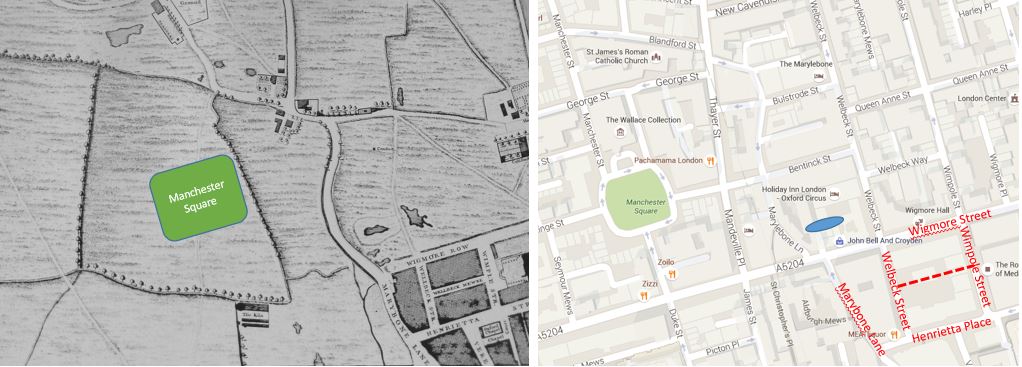
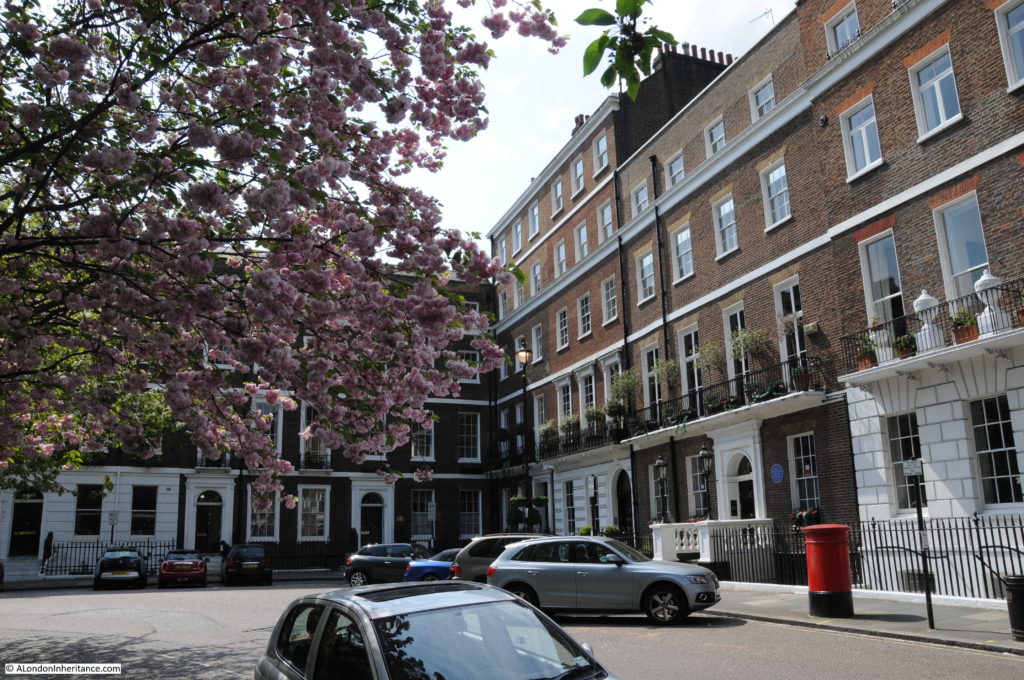
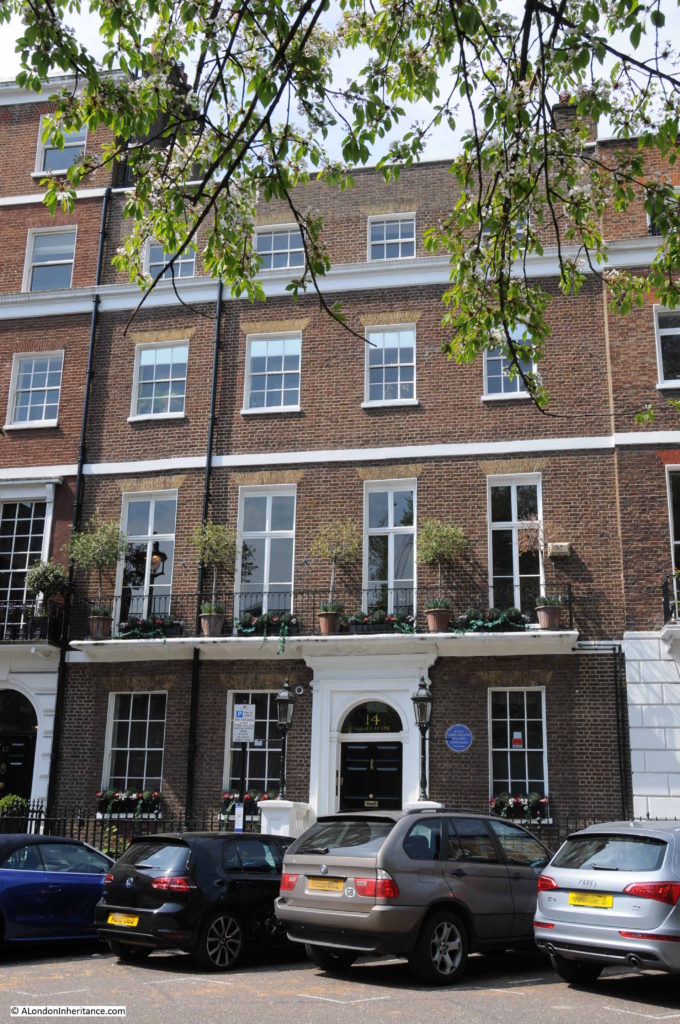
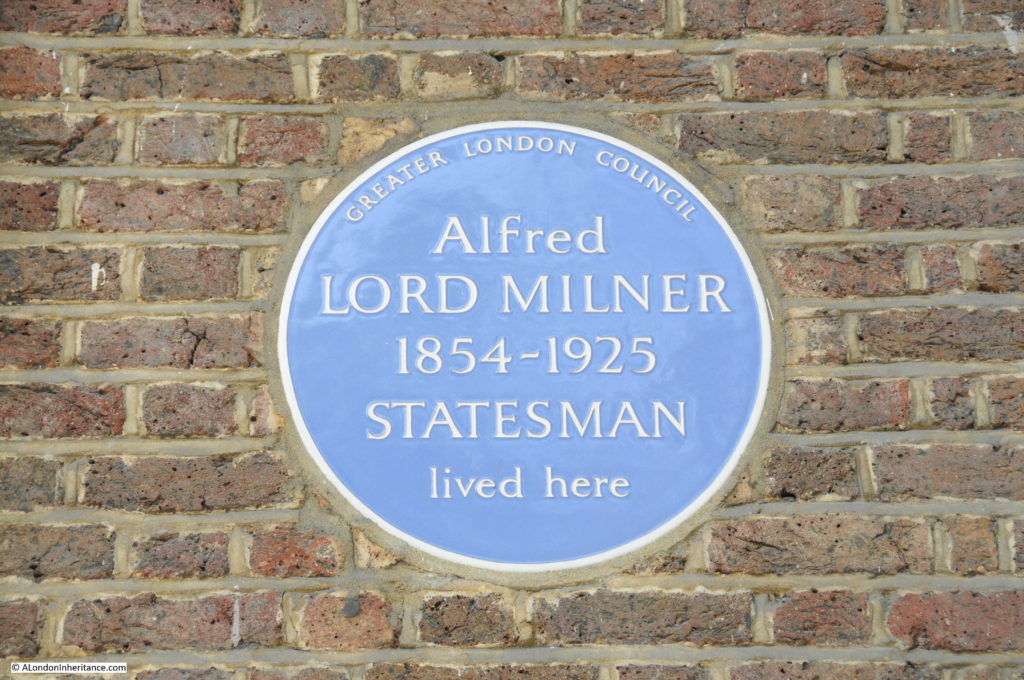
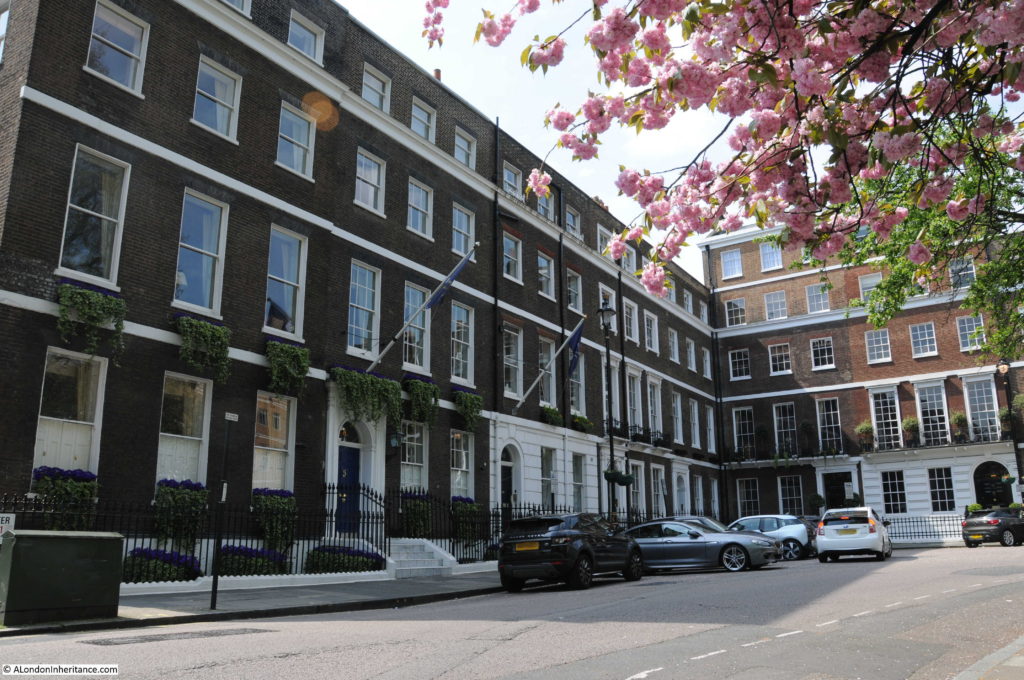
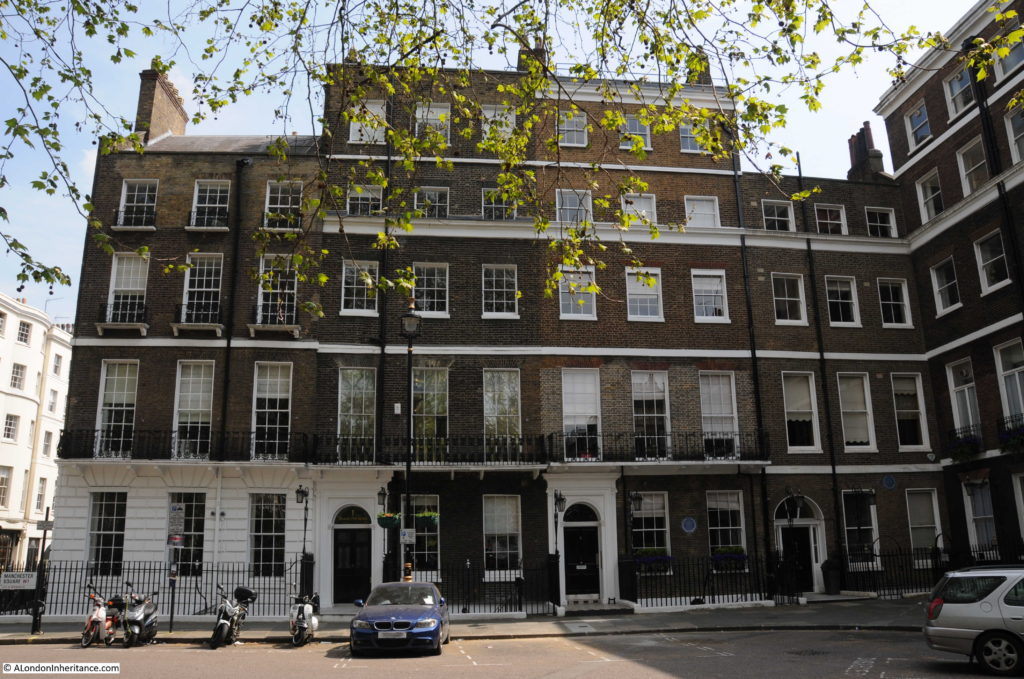


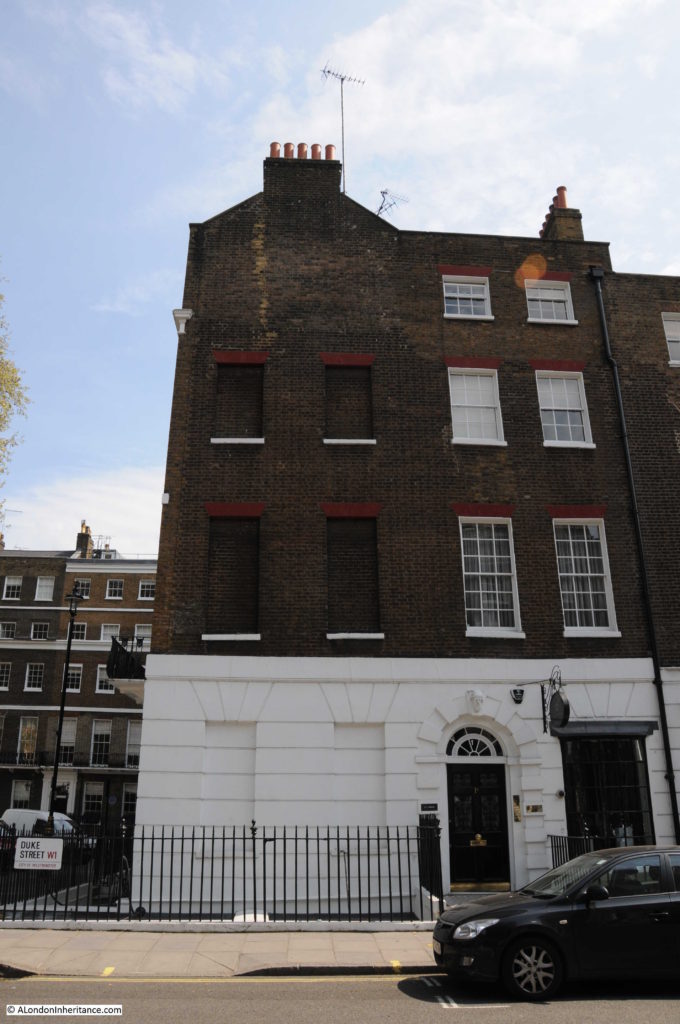
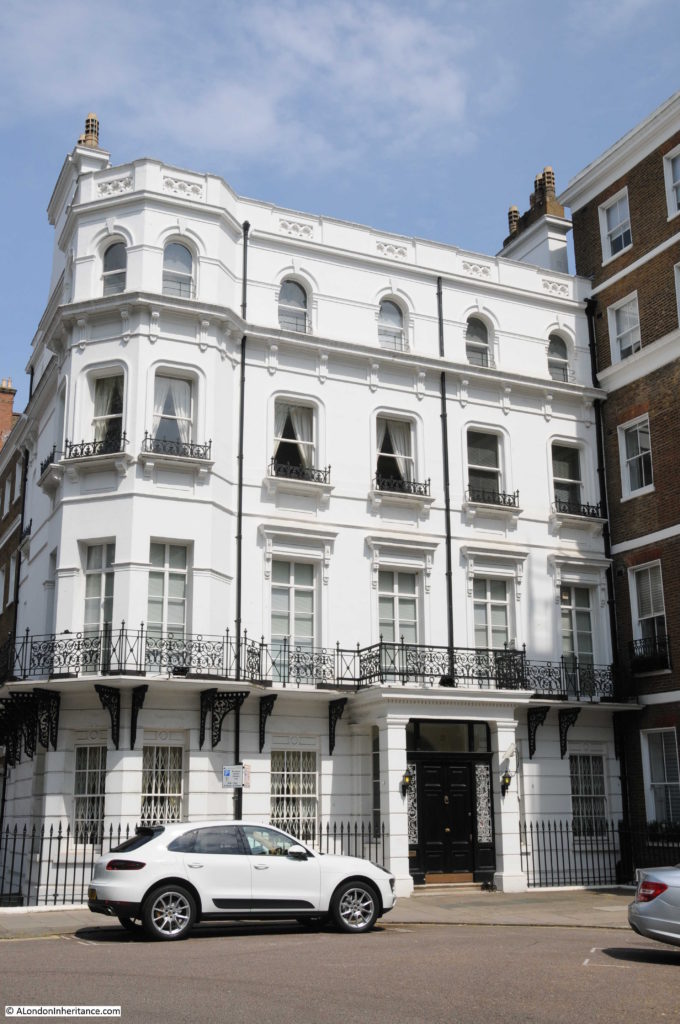

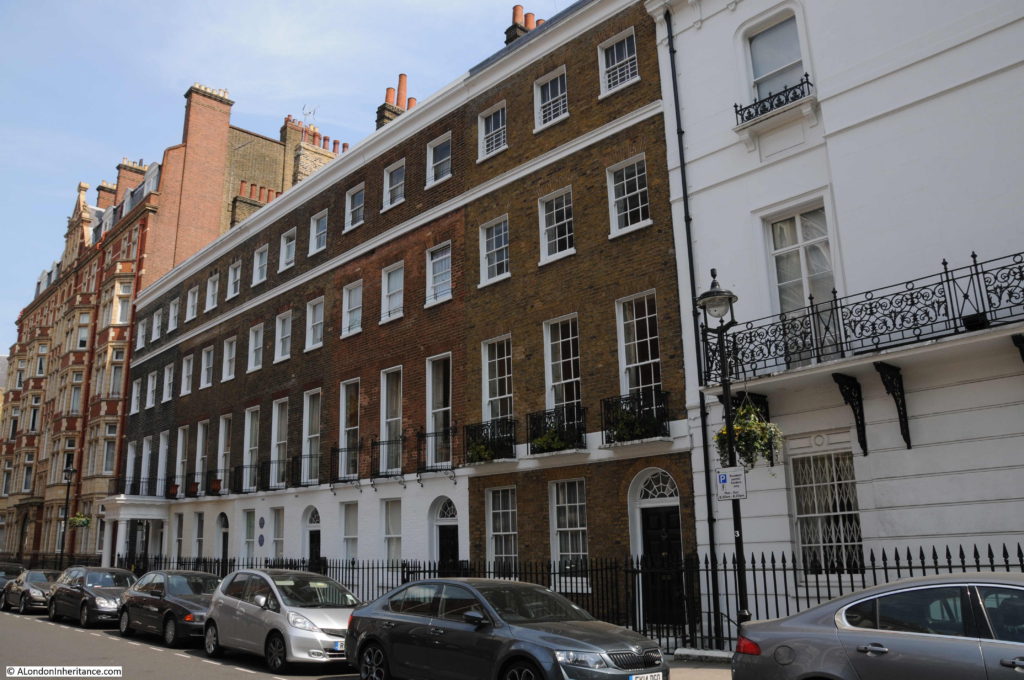
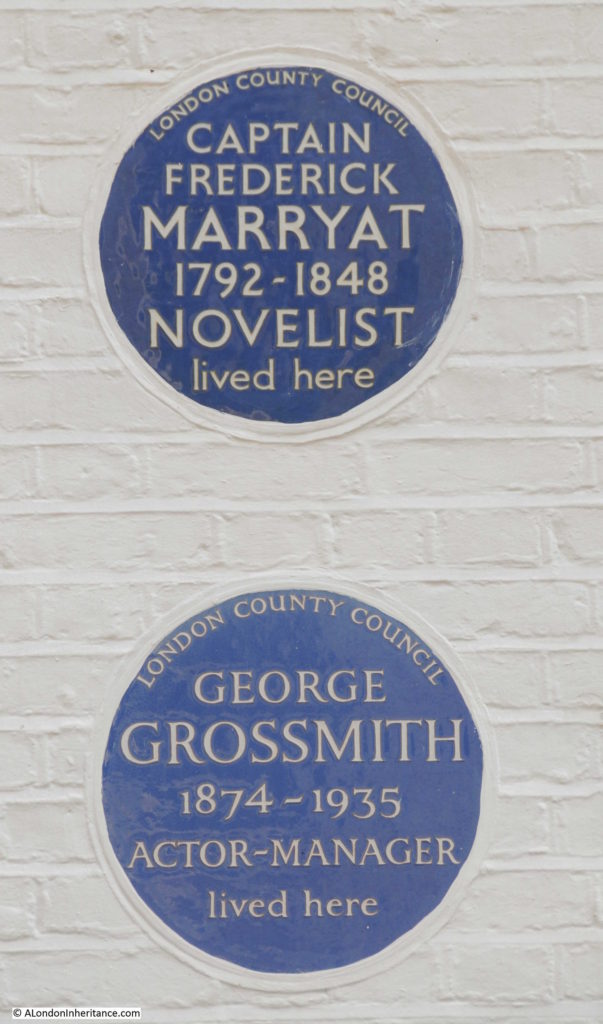
Thank you so much for this fascinating article and all your other articles about our wonderful city.
What a lovely start to the day reading this piece on Manchester Square. Fascinating and wonderful photos. Thank you very much.
Thanks especially for the comparative maps. I like the way the field boundaries have been almost but not completely overwritten. Here’s a nice piece of ‘Georgiana’ on Manchester Square: http://www.bl.uk/collection-items/broadside-on-the-pig-faced-lady.
I had a feeling I’d read somewhere that Marylebone Lane was the shap it was because it was following a stream, now lost underground like so many others. However that’s not at all obvious from the 1746 map. But I too have wandered down the Lane thinking what it must have been like 300 years ago.
Great pictures. Thanks as always.
M
This is a fascinating post; thank you! Although it’s a while since I visited, I’m very fond of the Wallace Collection. I particularly remember the paintings.
Your posts are a weekly delight, David, but this one arrives like a postcard from home. I lived at 25 Manchester Street (near the junction with Dorset Street) for five years, from 1968 till 1973. Back then, EMI Records occupied a post-war office building in the north-west corner of the square (since demolished). The cover shot for the Beatles’ first album shows them leaning over a street-side balcony at EMI House, grinning like cheeky chappies. Quite by happenstance, I was walking home from work through the square in 1969, saw a small crowd gathered outside EMI, looked up & there were the Fabs in their hippie pomp, being photographed by Angus McBean again, for what was intended as the cover of their album-in-progress. (It’s on the Blue Album: 1967-1970.)
My great-grandfather Stopford Brooke (the founder of the Wordsworth Trust at Grasmere) lived at 1 Manchester Square between 1866 and 1914. His large study was at the top of the very tall house, where he would entertain the likes of Robert Browning, Alfred Lord Tennyson, W.B.Yeats and Henry James. An unmarried sister looked after his seven motherless children, for whom Sunday lunch was the only time when they could be sure to see their father. who sat at the end of the long dining-room table. His long sermons stirred the conscience of late Victorian London.
I used to live just behind Marylebone High Street and often visited the Wallace Collection and marvelled. Marylebone Lane was my short cut home from Oxford Street and was meant to have followed the line of the old stream (bourne) that gave its name to the area. I believe it decanted itself further south and into the Thames. It is a funny little street, quite unlike others in the area.
Thank you, David. A late comment because I wait until there is time to read your posts thoroughly and do them justice. Fascinating as ever.
A “ridicule” was a genuine term for a handbag, and was seemingly interchangable with the possibly more correct word “reticule”. See http://regalregencyblog.blogspot.co.uk/2011/07/you-say-ridicule-and-i-say-reticule.html for instance.
I had the chance to share a basement flat with a friend in 1968 in the square, as she worked for the Portman family estates and the building was due for redevelopment. Unfortunately my parents wouldn`t allow it (I was 17) so it was back to the suburbs for me !!
Thank you for this insight into the square.
Great research on the history of this beautiful part of London.
I am researching the life of an Australian nurse, Matron Ida Greaves RRC, who gives her address as No 22 Manchester Square, 1912 – 1914, after which she went to France as a military nurse. Before the war she worked for Dr Jervois Aarons of Harley St. I am interested in what No 22 was used for at the time – a nurses’ home, a private hospital …?
Any information about the building in that period gratefully received.
Christine, NSW Australia
Hi Christine,
Kelly’s Post Office Directory for 1914 gives 22 Manchester Square as the home of Sir John & Lady Constance Leslie.
We might assume that the data was compiled and published in 1913.
Source: University of Leicester Special Collections Online
http://specialcollections.le.ac.uk/digital/collection/p16445coll4/search/searchterm/London/field/place/mode/exact/conn/and/order/nosort
It begs further questions, doesn’t it. Was it lodgings for matron? Was she nurse in residence for Sir John and Lady C? And it is certainly conveniently close for Harley Street.
Best wishes for your further research.
Pimlico Pete
Thank you, Pimlico Pete – I will see what I can discover about the Leslies. I think it is quite possible Ida was a nurse in residence – she had filled this role before leaving Australia, on the property of a wealthy landowner in the Hunter Valley.
Cheers, Christine
No doubt the 4th Marquis and Sir Richard Wallace were on friendly terms; however, according to Wallace Collection staff, Sir Richard was the Marquis’ illegitimate son, and also his secretary. Have you evidence to the contrary?
Many years ago I worked for the Howard de Walden Estate who own a lot of the land north of Wigmore Street. At the time, we believed that Marylebone Lane followed the route of the Tyburn Stream which would be uncovered sometimes when doing building works.